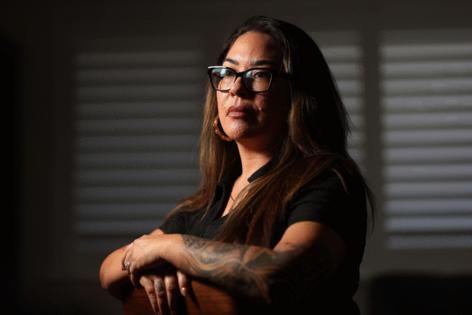Resentencing effort works with California DAs to reunite incarcerated mothers with their families sooner
Published in Mom's Advice
Five years after state law empowered prosecutors to recommend the early release of people who have substantially rehabilitated in prison, an architect of the landmark reform saw something starkly missing: women prisoners were a tiny fraction of those set free.
“We see this across every industry. We’re underrepresented,” said Hillary Blout, executive director of the nonprofit For the People, and a former San Francisco prosecutor. “It was clear to us that there needed to be a concerted effort to actually target and focus on cases involving women.”
She concedes men will always represent the vast majority of people who benefit from prosecutor-initiated resentencing, which was instituted in 2019. That’s just simple math: Men make up 95% of California’s prison population.
But Blout says she was still jarred by how few women were represented: By her group’s estimate, they accounted for barely 1% of the approximately 600 people who have been resentenced under the law.
She added that the issue is at a fever pitch given the chronic abuse of women in prison. That crisis has seized the public’s attention perhaps most acutely with the officer sexual abuse scandals that forced the closure of FCI Dublin in the Bay Area.
Earlier this year, Blout’s group launched Together Home — stylized in its literature to evoke the phrase “to get her home” — partnering with several district attorney’s offices across the state and women-focused reentry organizations to increase the number of women who benefit from the sentencing relief.
“There are some real unique and urgent issues that are arising that really call on DAs to take this much more concerted approach,” Blout said. “If women (in prison) are experiencing things counter to rehabilitation, we have to get them out.”
Blout says Together Home entails specialized prosecutor training and comprehensive post-release support for eligible women. She is quick to point out that the initiative is not designed to achieve a specific numerical outcome, but to ensure prosecutors are weighing the impact of prior trauma in their crimes alongside their rehabilitation record.
“As a result of this training, DAs will be coming to some of the women’s prisons, talking to experts, hearing from incarcerated people, and seeing the impact of rehabilitative programs,” she said. “Through all of this, we’re going to see more women get resentenced.”
One of the goals of the initiative is to, when possible, account for the outsized effect the loss of a mother has on family stability: Advocates point to federal figures showing that around 60% of incarcerated women are mothers to minor children.
“You are parenting behind bars, but you are still a parent,” said Amika Mota, a formerly incarcerated woman and executive director of the Sister Warriors Freedom Coalition. “The role women play in a community … it’s massive, the ripple effects when a woman is removed from the household.”
Mota said she vividly remembers the pain and struggle of being separated from her three children — the youngest being 6 years old — after her conviction in Orange County in 2008, following a fatal DUI. She served seven years of a 10-year sentence before being released in 2015.
“I had lived a life as a good mother, a good woman, and in that moment it was all kind of wiped out,” Mota said. “The worst impact was on my three children. I had done something wrong, but for them, life exploded. That type of weight you can’t explain. Your whole family is paying now.”
Mota is often held up as a testament to the power of rehabilitation in prison. Now a Bay Area resident, she leads an organization that supports, and is operated by, current and formerly incarcerated women, and is one of four reentry-focused groups backing the Together Home initiative.
She recalled how her responsibilities as a mother did not cease when she was imprisoned. Once she was able to have family visits, she fielded all manner of questions and issues from her children. That included trying to help her daughter, a budding teenager, navigate her growing womanhood.
“I remember her telling me, ‘Mom I got my period,’ and nobody could parent them. They would save all their questions for these 15-minute phone calls,” Mota said.
Mota also emphasized that anyone being considered for prosecutor-initiated resentencing is part of a select group of people who have demonstrated genuine transformation while incarcerated.
“The level of vetting is so intense and rigorous. These people are not the people they were. After that much time inside the system, they’re on a trajectory toward healing,” Mota said. “All of those things are considered before anyone gets this evaluation.”
For the People says their initiative is also aimed at ensuring that prosecutors recognize that between 70% and 80% of women in prison experience physical or sexual abuse, intimate partner abuse, and sometimes all of the above.
Two Bay Area district attorney offices, in Santa Clara County and Contra Costa County, are among the six prosecutor shops in the state that are part of the Together Home program. David Angel, an assistant district attorney in Santa Clara County, said that even with the success of prosecutor-initiated resentencing, the dearth of women in their statistics was a signal they needed to revisit their evaluation methods.
“One of the lessons we’re all trying to learn, in viewing ourselves and systems accordingly, is to ask if it is possible that we’re not really getting at the truth. Are we leaving people behind who deserve this relief?” Angel said. “We want to educate ourselves more, like asking if are there drivers for women in crime that bring them into it, that we are currently blind to in our resentencing.”
Contra Costa County District Attorney Diana Becton said the issue deserves attention, pointing to figures showing that even as women remain a small minority of imprisoned people in the United States, their numbers have increased fivefold since 1980.
“With that kind of family disruption, it’s a very important part of the work we’re doing to concentrate on women and successfully transition them home,” Becton said. “It will help lead us to safer communities.”
Mota said the broader goal reflected in Together Home and similar work is to recognize how women are being forced to conform to a justice and prison system made primarily to punish and incarcerate men.
“We’re not just an afterthought. None of this was designed for us,” she said. “We’re inside working with women who have been lost and forgotten.”
_____
©2024 MediaNews Group, Inc. Visit at mercurynews.com. Distributed by Tribune Content Agency, LLC.










Comments